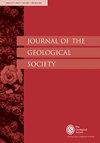Tectonometamorphic evolution of the Himalayan metamorphic core in the Makalu-Arun region, eastern Nepal
IF 3
3区 地球科学
Q2 GEOSCIENCES, MULTIDISCIPLINARY
引用次数: 0
Abstract
The metamorphic core of the Himalayan orogen, once viewed as a structurally contiguous unit, is now known to be divided into multiple packages by a series of structural discontinuities. While these structures have been identified based on distinct metamorphic and kinematic histories of the bounding packages, the number of structures identified across the exhumed former midcrustal core varies throughout the Himalaya. The scarcity of field evidence for these structures not only impedes their identification, but also hinders our understanding of their role in the development of the Himalaya. This study characterizes the metamorphic and geochronological history of garnet, sillimanite, and kyanite bearing gneisses in Makalu-Arun region, Nepal. Phase equilibria modelling coupled with monazite U/Th-Pb petrochronology delineates four rock packages with distinct metamorphic histories separated by at least three thrust-sense structures. The earliest thrust activity and subsequent in-sequence thrusting lasted from ca. 23-14 Ma, with initiation of late out-of-sequence thrust after ca.14 Ma. These results are consistent with foreland thrust migration and juxtaposition consistent with models that incorporate underplating, metamorphism and exhumation of midcrustal rocks during orogenesis. Moreover, the demonstrated complex evolution of the metamorphic core in Makalu region is inconsistent with models that incorporate singular, orogenic-wide structures in the Himalaya. Supplementary material: https://doi.org/10.6084/m9.figshare.c.6420244尼泊尔东部马卡鲁-阿伦地区喜马拉雅变质核的构造变质演化
喜马拉雅造山带的变质核心,曾经被视为一个结构上连续的单元,现在已知被一系列结构不连续性划分为多个包。虽然这些结构是根据边界包的不同变质和运动学历史确定的,但在整个喜马拉雅山脉,挖掘出的前中地壳核心中确定的结构数量各不相同。缺乏这些结构的实地证据不仅阻碍了它们的识别,也阻碍了我们对它们在喜马拉雅山脉发展中的作用的理解。本研究描述了尼泊尔马卡鲁-阿伦地区石榴石、硅线石和蓝晶石片麻岩的变质和地质年代学历史。相平衡建模与独居石U/Th-Pb岩石年表相结合,描绘了四个具有不同变质历史的岩石包,由至少三个逆冲感结构分隔。最早的逆冲活动和随后的序内逆冲持续了约23-14Ma,晚序外逆冲在约14Ma之后开始。这些结果与前陆逆冲迁移和并置一致,与造山运动期间中地壳岩石的底侵、变质和剥露模型一致。此外,马卡鲁地区变质核的复杂演化与喜马拉雅山脉奇异造山带宽结构的模型不一致。补充材料:https://doi.org/10.6084/m9.figshare.c.6420244
本文章由计算机程序翻译,如有差异,请以英文原文为准。
求助全文
约1分钟内获得全文
求助全文
来源期刊

Journal of the Geological Society
地学-地球科学综合
CiteScore
6.00
自引率
3.70%
发文量
68
审稿时长
6-12 weeks
期刊介绍:
Journal of the Geological Society (JGS) is owned and published by the Geological Society of London.
JGS publishes topical, high-quality recent research across the full range of Earth Sciences. Papers are interdisciplinary in nature and emphasize the development of an understanding of fundamental geological processes. Broad interest articles that refer to regional studies, but which extend beyond their geographical context are also welcomed.
Each year JGS presents the ‘JGS Early Career Award'' for papers published in the journal, which rewards the writing of well-written, exciting papers from early career geologists.
The journal publishes research and invited review articles, discussion papers and thematic sets.
 求助内容:
求助内容: 应助结果提醒方式:
应助结果提醒方式:


